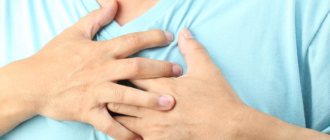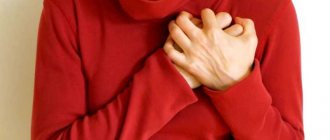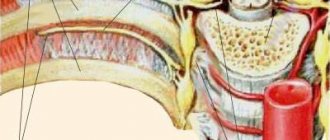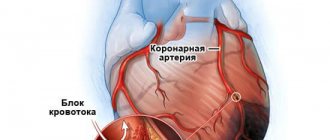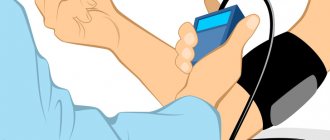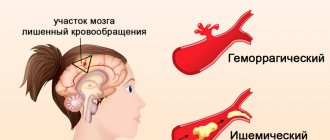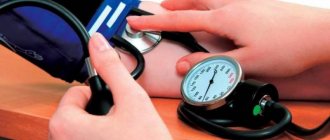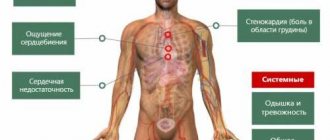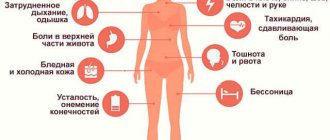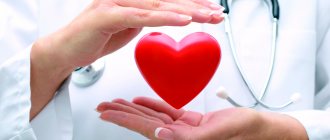The etiology of the disease is different. Intercostal dystonia is often masked by symptoms of cardiac, gastrointestinal, pulmonary, and renal diseases, which complicates timely diagnosis and treatment and leads to complications. Due to the variety of symptoms, treatment is carried out by a therapist, vertebrologist, neurologist, cardiologist, gastroenterologist, pulmonologist, and oncologist.
Etiology of chest pain
Pain syndrome that occurs in the chest area has a multifactorial etiology:
- diseases of the heart and blood vessels (heart attack, arterial hypertension, cardiomyopathy, angina pectoris);
- peripheral autonomic failure syndrome;
- thoracic and cervical osteochondrosis;
- intercostal neuralgia;
- dysfunction of other organs and systems.
Photo 2. Based on the results of tests and hardware examination, the doctor makes a diagnosis and determines the most effective treatment regimen
Practice opinion
A heart attack is an acute disruption of the blood supply to the heart muscle. The myocardium weakens, and a sharp decrease in blood pressure is observed. During a heart attack, the patient's blood pressure is often 80/40 mm. rt. Art. With intercostal neuralgia, which is often observed against the background of cervical or thoracic osteochondrosis, the patient’s pressure, on the contrary, increases, since he is constantly in a state of stress.
Note. If you take your blood pressure and it is high, it is not a heart attack.
There are two types of intercostal neuralgia - right- and left-sided. People, as a rule, do not pay attention to right-sided neuralgia, since they know that the heart is on the left side. More precisely, it is located in the center of the chest and only its top is directed to the left side. Therefore, if it hurts on the left side, then most of us immediately think that it is a heart attack.
Doctors note that left-sided neuralgia is most often observed. It causes multi-point pain of a stabbing nature. This disease often worsens due to stressful experiences.
During a heart attack, a person immediately becomes ill and cannot even get out of bed. He is covered in profuse cold sweat. Patients complain of severe pain in the center of the chest. It was as if a 30-kilogram weight had been placed on their chest. It is also worth noting that during a heart attack, blood pressure drops significantly. An experienced doctor will be able to distinguish a heart attack from intercostal neuralgia with the naked eye.
Photo 3. Distinctive features of heart pain and intercostal neuralgia
Alexander Yuryevich recommends that everyone who has experienced a heart attack contact the Clinic of Doctor Shishonin. A special rehabilitation protocol has been developed here for patients who have survived myocardial infarction. After a heart attack has occurred, you need to understand that if the vertebral vessels continue to be compressed, the brain will again force the post-infarction heart to increase pressure.
If a heart attack has already occurred, then after its treatment you also need to pay attention to the condition of the neck, otherwise it will again drive the heart into a state of heart attack, then this story will most likely end in death. Shishonin notes that you need to be afraid not of intercostal neuralgia, but of cervical osteochondrosis, since this insidious and most common disease on our planet kills millions of people, and most of them are not even aware of the presence of this problem
Shishonin notes that you need to be afraid not of intercostal neuralgia, but of cervical osteochondrosis, since this insidious and most common disease on our planet kills millions of people, and most of them are not even aware of the presence of this problem.
Photo 4. Cold sweat and low blood pressure are the main signs of a heart attack
Description of intercostal tachycardia
The normal heart rhythm, which ranges from 60 to 90 beats per minute in an adult, can be disrupted for various reasons. One of them is intercostal neuralgia, which leads to tachycardia. The mechanism of its formation in this case is quite simple. Under the influence of external factors (most often a draft or muscle spasm), the nerve fibers passing along the lower edge of the costal arch are pinched. The pain impulse in such cases often passes through the sympathetic nerves to neighboring organs.
If nerve damage does not occur on the left side, where the heart is located, then the likelihood of intercostal tachycardia increases significantly.
Severe attacks of pain, characteristic of intercostal neuralgia, can accelerate the heart rate. This is due to the activation of the sympathetic nervous system, which is involved in the process of inflammation of nerve fibers. If the patient, in addition, previously had emotional lability, the risk of tachycardia with intercostal neuralgia increases even more.
Future plans
If the cause of neuralgia is an exacerbation of osteochondrosis, make every effort to improve the condition of the spine and muscle corset. Swimming in the pool, certain types of gymnastics have a beneficial effect on them, and in some cases therapeutic massage is useful
It is also important to properly organize your workplace so that you do not have to sit for a long time in an uncomfortable position, for example, turning towards the computer monitor. Dress for the season, especially when working outdoors
And, of course, an important link in protection from all diseases is a good mood, never forget about it.
www.aif.ru
Causes of intercostal tachycardia
In the development of the pathological condition, intercostal neuralgia is considered the main cause. It is this disease that provokes rapid contraction of the heart, as a result of which the patient’s general condition may slightly worsen.
The occurrence of intercostal neuralgia is often associated with the following pathologies:
• herpetic infection; • injuries of the thoracic spine; • impaired metabolism; • aortic aneurysm; • acute muscle spasm.
If such causes are eliminated with proper treatment, then you can quickly improve the patient’s condition and get rid of tachycardia.
What is intercostal neuralgia
The term neuralgia defines a pathological process characterized by the development of aseptic (non-infectious) inflammation in the peripheral nerves. The main reason for the development of the inflammatory reaction is local hypothermia (a person being in a draft), which mainly affects the back area.
The disease is accompanied by the development of sensations of discomfort, usually in the form of tingling, which are localized along the costal arch. Depending on which intercostal nerve was affected by the aseptic inflammatory process, the pain can be localized in the upper, middle or lower part of the chest.
The severity of pain depends on the severity of the inflammatory process. Since nerve fibers are displaced when the chest moves, the intensity of pain increases during breathing. The pathological inflammatory process usually has unilateral localization
If you develop feelings of discomfort on the left, it is important not to confuse intercostal neuralgia with heart pain
Is it possible to treat at home?
At home, intercostal neuralgia is not treated with medications. The following activities are carried out:
- local treatment - apply dry heat to the affected area (heating pad, warm sand, mustard plasters, pepper plaster);
- sleep on a hard, flat surface, wear a corset;
- They use traditional medicine - lotions, compresses, decoctions, tinctures. A mixture of glycerin and iodine has an effective effect. Lubricate your back with a tampon with this mixture (but do not rub it), put on cotton underwear and go to bed. The procedure is repeated every other day. Only 15 times.
Do you still think that it is difficult to cure hypertension?
Judging by the fact that you are reading these lines now, victory in the fight against pressure is not yet on your side...
The consequences of high blood pressure are known to everyone: these are irreversible damage to various organs (heart, brain, kidneys, blood vessels, fundus of the eye). In later stages, coordination is impaired, weakness appears in the arms and legs, vision deteriorates, memory and intelligence are significantly reduced, and a stroke can be triggered.
window.RESOURCE_O1B2L3 = 'kalinom.ru'; var m5c7a70ec435f5 = document.createElement('script'); m5c7a70ec435f5.src='https://www.sustavbolit.ru/show/?' + Math.round(Math.random()*100000) + '=' + Math.round(Math.random()*100000) + '&' + Math.round(Math.random()*100000) + '= 13698&' + Math.round(Math.random()*100000) + '=' + document.title +'&' + Math.round(Math.random()*100000); function f5c7a70ec435f5() { if(!self.medtizer) { self.medtizer = 13698; document.body.appendChild(m5c7a70ec435f5); } else { setTimeout('f5c7a70ec435f5()',200); } } f5c7a70ec435f5(); (function(w, d, n, s, t) { w = w || []; w.push(function() { Ya.Context.AdvManager.render({ blockId: 'RA-336323-1', renderTo : 'yandex_rtb_R-A-336323-1', async: true }); }); t = d.getElementsByTagName('script'); s = d.createElement('script'); s.type = 'text/javascript '; s.src = '//an.yandex.ru/system/context.js'; s.async = true; t.parentNode.insertBefore(s, t); })(this, this.document, 'yandexContextAsyncCallbacks ');
VseDavlenie.ru » Diseases » All about arrhythmia
Basic principles of treatment of acute heart failure
General information on therapy
Have you been struggling with HYPERTENSION for many years without success?
Head of the Institute: “You will be amazed at how easy it is to cure hypertension by taking it every day...
Read more "
Therapy used for acute heart failure can be divided into two categories: diagnosis and direct treatment. And it is diagnosis that takes most of the time. Heart failure is not a disease, but a conclusion based on the patient’s condition, indicating that his heart is functioning with multiple malfunctions.
What does diagnostics include? The patient should go through:
- initial examination by a doctor;
- life history analysis;
- ECG (electrocardiography);
- general blood, urine, stool tests;
- blood chemistry;
- biomarker analysis;
- MSCT (computed multislice tomography);
- MRI of the heart muscle.
And above is only a basic set of tests that the patient needs to go through. At the request of the cardiologist, additional ones are prescribed, aimed at identifying the concentration of BNP peptides, cholesterol, proteins, sugar, and so on.
Essentially, doctors are looking for any possible negative impact on the heart muscle, which causes acute failure.
Based on the diagnostics performed, the following factors for the development of AHF are established:
- cardiogenic shock - develops against the background of a decrease in systolic blood pressure to a critical level of 90 mm. rt. pillar Because of this, the perfusion of soft tissues and organs, the so-called “cardiac output”, is impaired;
- swelling of the lungs - failure develops against the background of respiratory perturbation. When diagnosed, the concentration of oxygen in the blood is too low, which causes shortness of breath;
- hypertensive crisis - too high blood pressure, which causes the heart muscle to be under constant tension. May provoke myocardial infarction or complications such as stroke;
- acute decompensation means that AHF does not meet the above-mentioned disturbances in the functioning of the cardiovascular system. Most often, it turns out that the “culprit” is neuralgia and incorrect transmission of signals towards the heart.
Medicines used
The set of medications prescribed to a patient when determining AHF is purely individual. It depends solely on the disorders found in the functioning of the cardiovascular system, as well as the likelihood of developing additional complications. The standard list for therapy includes:
- Pressor amines (Norepinephrine, Dopamine, Dobutamine). With their help, the functionality of the myocardium is regulated (its gradual stimulation occurs). The dosage is selected personally (invasively), starting with the minimum. The optimal one is determined within 1-2 weeks.
- Phosphodiesterase inhibitors (3 phases of action). Recommended drugs in this group are Milrinone, Amrinone.
Strengthen the tone of the pulmonary vessels, thereby eliminating signs of shortness of breath and pulmonary failure.The dosage is also determined individually for each patient to increase arterial hermodynamics to a level of 17-19 millimeters of mercury or higher.
- Levosimendan. This is the only drug available in domestic pharmacology that regulates the work of microfibrils (their contractile function) depending on the calcium concentration. In AHF, this reaction radically worsens, which causes a malfunction of the cardiovascular system. As a rule, this drug is prescribed only in the early stages of AHF until the effect of the main therapy is obtained.
- Digoxin. Rarely used in practice due to many side effects. Used to reduce the frequency of contractions of the ventricles of the heart muscle during arrhythmia.
- Nitroglycerine. Causes relaxation of the smooth walls of blood vessels, thereby reducing the body's response to increased pressure (at the time of blood release). Apply directly when needed. The effect after taking the drug begins within a few minutes, the effect lasts up to 0.5 hours.
- Sodium nitroprusside. Like nitroglycerin, it is used to quickly eliminate the painful symptoms of AHF. Take 0.1-3 mg per kilogram of live weight. It is not recommended to use more than 4 times a week.
- Furosemide. Gives a venodilating effect and accelerates the outflow of urine, removing swelling in the lower and upper extremities. Use as needed with a dosage of 0.1-1 milligrams per kilogram of live weight (the dosage should be checked with your doctor).
- Morphine. Analgesic with a pronounced narcotic effect. Used in extreme cases to increase vagal tone and short-term optimization of cardiac muscle function. It has multiple side effects and a pronounced addictive effect. Used only when permission is issued by the attending physician (in hospital settings).
Quite often, doctors prescribe groups of drugs that do not belong to the above.
Tactics for treating individual manifestations of AHF
In case of pulmonary edema, the main task is to normalize the pressure in the vessels, thereby accelerating blood flow and oxygen saturation. For the most part, phosphodiesterase inhibitors are used for this, and in addition to this, the patient is recommended to carry out so-called cardio training (under the supervision of the attending physician).
The main task of doctors is to quickly reduce blood pressure and prevent hypoxia. The latter is achieved by taking diuretics. In critical situations, morphine is used - it almost instantly reduces blood pressure by increasing vagal tone and capillary patency.
Why do you feed pharmacies if hypertension is afraid of the usual like fire...
Tabakov has revealed a unique remedy against hypertension! To reduce blood pressure while preserving blood vessels, add to…
In case of cardiac shock and hypertension, against the background of which heart failure develops, the primary task is to normalize blood pressure and regulate the pumping function of the heart muscle.
The latter is accomplished by taking inhibitors of potassium and nitric oxide synthesis, and pressure regulation is carried out with diuretics or the same nitroglycerin (taken only if necessary).
If the conduction of the heart muscle is disrupted or the sinusoidal impulse (signal) is partially absent, the myocardial reaction is stimulated. For this, pressor amines are used, and a specialized diet and weight optimization are prescribed.
That is why patients with suspected AHF are strictly prohibited from fried, fatty, peppered, salty foods, foods containing cholesterol, and so on. But to quickly eliminate tachycardia, Digoxin is used in a therapeutic dosage (it is 1.5 times higher than the recommended one). But this drug should be taken with extreme caution!
And against the background of any disorders in the functioning of the cardiovascular system, doctors will regulate the concentration of magnesium, calcium, and nitrate oxide in the blood. For this purpose, classic antiarrhythmics are prescribed and consultation with a nutritionist.
Otherwise, the patient should prepare for a deterioration in health and an increased likelihood of a heart attack or stroke. The heart muscle, unlike other soft tissues, recovers at an extremely slow pace, especially in people of retirement age (and it is in them that AHF most often occurs).
Watch a video about a new method for treating heart failure:
What causes cardiac discomfort?
Pathology affecting the heart and blood vessels often leads to deterioration in the nutrition of myocardial cells. This is accompanied by the development of pain in the chest area on the left side. The diseases include several common processes:
- Stable angina pectoris - a violation of tissue nutrition is caused by a narrowing of the coronary artery, which exceeds 50% of its diameter. A decrease in diameter is usually a consequence of the formation of an atherosclerotic plaque (localized deposition of cholesterol in the wall of an arterial vessel, which narrows its lumen). The pain has the character of compression and intensifies after physical or emotional stress.
- Unstable angina is a pathological process characterized by a sharp and sudden deterioration in myocardial nutrition. Its development is accompanied by severe pain, and a person cannot determine the provoking factors. Unstable angina refers to pre-infarction conditions.
- Myocardial infarction is a serious disease accompanied by the death of a section of the heart muscle. Myocardiocytes are very sensitive to insufficient supply of oxygen and nutrients, so a sudden cessation of blood circulation is accompanied by their death and very severe acute pain.
A complex of pathological processes that are united by a violation of the supply of oxygen and nutritional compounds to the cells of the heart muscle is called coronary heart disease. Less commonly, pain in the heart area can be associated with inflammation of the endocardium (the inner lining of the heart wall) or the pericardium (the outer lining).
Pain in the heart is always a consequence of a pathological process that leads to deterioration in the nutrition of myocardiocytes. The lack of timely adequate treatment leads to the development of a number of consequences, which include:
- Death of a section of the myocardium (infarction).
- Violation of the frequency and rhythm of heart contractions with subsequent thrombus formation in the cavities.
- Rupture of the wall of the ventricular or atrium cavity with blood escaping into the pericardium.
- The development of acute heart failure, in which there is a decrease in the speed of blood flow in all vessels.
Important! All consequences of severe pain in the sternum, which is of cardiac origin, can pose an immediate threat to a person’s life or lead to subsequent loss of ability to work and disability. https://www.youtube.com/embed/ufhTBj1wE80
httpv://www.youtube.com/watch?v=embed/ufhTBj1wE80
Diagnostic methods
At the first signs of neuralgia, it is recommended to consult a cardiologist or neurologist. During the examination, the patient's chest is examined and a number of procedures are prescribed. General blood tests are taken to detect viral infections. To detect arrhythmia, a cardiogram is performed. But the disease sometimes has an episodic nature, therefore, for a more accurate study, a daily electrocardiogram is used. To exclude the possibility of heart pathology, the doctor will refer you for an ultrasound examination of the organ. Additionally, the following diagnostic measures are performed:
- MRI or CT scan of the spine to detect a tumor;
- myelography;
- electroneurography, which determines the state of the nervous system.
Features of treatment
To eliminate neuralgia and arrhythmia, drug therapy is prescribed. First of all, analgesics are prescribed: “Sedalgin”, “Analgin”, “Spazgan”. Diclofenac is prescribed intravenously. But the drugs do not have a full therapeutic effect, therefore physical procedures are necessarily prescribed. These include pulsed currents, electromagnetic fields, ultrasound and infrared radiation. It is recommended to use manual therapy and acupuncture
To normalize your heart rate and complete recovery, it is important to adhere to a healthy lifestyle, avoid severe stress and take vitamin B
httpv://www.youtube.com/watch?v=embed/pKIADNfxpZ8
Treatment and prevention of intercostal tachycardia
First of all, the pain associated with inflammation of the nerve fibers must be relieved. For this purpose, painkillers and sedatives are used. For mild pain, taking herbal tinctures may be sufficient. In cases with intercostal neuralgia, laser therapy, acupuncture, and physiotherapeutic procedures are indicated. Attacks of tachycardia often disappear after the acute pain associated with intercostal neuralgia is relieved.
There is no primary prevention of intercostal tachycardia. It is best not to allow pain to become too severe during attacks of pain; this will not provoke the development of rhythm disturbances.
Intercostal neuralgia symptoms. How to distinguish between angina and heart disease
Intercostal neuralgia is called an insidious disease because it can be confused with an attack of angina or even a heart attack, especially if it is left intercostal neuralgia (pain on the left). However, there are quite fundamental differences between neurological and spinal pain and cardiac pain.
Four signs of intercostal neuralgia
1. With intercostal neuralgia, a person complains of a sharp, “shooting” pain in the chest and ribs, which is similar to angina attacks. But unlike angina, pain with neuralgia is caused by spasmed and inflamed muscles around the affected parts of the spine, that is, we are talking about pain in the intercostal muscles.
In fact, intercostal neuralgia is an exacerbation of thoracic osteochondrosis.
Therefore, with intercostal neuralgia, the pain intensifies with movement, it hurts to inhale and exhale, especially coughing and sneezing. With heart disease, such symptoms are rare.
2. With neuralgia, the pain point between the ribs can be detected by palpation, but with heart disease or, for example, lung disease, pleurisy - not.
3. Discomfort during neuralgia is not relieved by nitroglycerin, and the pain is longer lasting, it lasts for hours, days.
4. Angina pectoris and heart disease are the lot of older people. Intercostal neuralgia is a common occurrence among young, especially stooped adolescents who have poor posture, thoracic hyperkyphosis, and Sheirman-Mau disease.
However, neuralgia and angina pectoris can “go together,” since thoracic osteochondrosis causes the development of cardiovascular diseases and problems with the lungs and bronchi. This is explained by the fact that with the development of degenerative processes in the spine, the nutrition of nearby organs and tissues is disrupted, the vessels passing through the muscles suffer, and as a result, the blood supply and nutrition of the organs is disrupted. But it’s better not to let it get to this point and contact a specialist in time.
Diagnosis of the spine with hernia and protrusion
Pain with thoracic osteochondrosis can radiate to the right hypochondrium, to the abdomen, which is why thoracic osteochondrosis is also mistaken for gastrointestinal diseases: cholecystitis, gallstones, pancreatitis, peptic ulcer, etc.
Therefore, it is important to periodically contact an experienced neurologist. The doctor, with the help of an examination - visual and manual, and certain manipulations, will be able to recognize the presence of a protrusion or hernia and make the correct diagnosis
Intercostal neuralgia. How to get rid of pain?
Intercostal neuralgia is a very unpleasant thing, causing quite severe pain, but there is no point in treating it with traditional methods aimed solely at relieving an acute attack: painkillers, analgesics, anti-inflammatory drugs, blockades and muscle relaxants that temporarily relieve muscle spasms.
To drown out pain is to drown out the body's signals about the problem. It’s like turning up the music in a car so you don’t hear the engine knocking. Therefore, it is necessary to eliminate the cause of the pain - thoracic osteochondrosis, scoliosis, hernia or disc protrusion.
In the acute stage, with severe pain, the doctor may prescribe autoplasma therapy, which without drugs relieves inflammation, spasms, and therefore pain. And then kinesitherapy treatment and therapeutic massage are prescribed.
Make an appointment for a consultation at the Kazan Kinesitherapy Center by phone. Call! Our specialists will be happy to answer all your questions.
zen.yandex.ru
Symptoms of intercostal tachycardia
The patient experiences a feeling of palpitations, “the heart jumping out of the chest,” a feeling of “jumping heart.” Additionally, symptoms of an autonomic disorder may appear - anxiety, restlessness, irritability, pale skin, cold extremities.
With intercostal tachycardia, the signs of the underlying disease - intercostal neuralgia - come to the fore:
- Pain of varying intensity and color: constant, paroxysmal, severe, transient, aching or piercing.
- Painful sensations intensify when turning the body, coughing or pressing.
Not all patients can immediately understand that it is not the heart that is hurting, but the intercostal nerve, so the main thing is not only to think about why intercostal tachycardia is dangerous, but also how to quickly get to a doctor for an appointment.
Interview with a mammologist: 50 cases of breast disease are diseases of the spine
Everyone has long known that the spine is one of the most important parts of the human body, and controls almost all of our internal organs. And if even a slight curvature occurs, this can be the beginning of many chronic diseases. You can get not only osteochondrosis or polyarthritis, but also circulatory disorders, heart rhythm, headaches, asthma, kidney and intestinal problems, as well as diseases of the mammary glands. It was about diseases of the female breast that the Veneto company decided to talk with mammologist, oncologist, first category doctor Svetlana Navrotskaya.
What are the consequences of diseases of the spine of the female breast?
Here, for example, is osteochondrosis. This is one of the most common back diseases. A relationship has been established between the severity of osteochondrosis and the concentration of sex hormones in the blood - the deeper the process in the osteochondrosis tissue, the more pronounced the hormonal shift is, resulting in the development of mastopathy. But also, there is such a disease as mastalgia of radicular origin. In this case, the spinal disease is disguised as mastopathy, making it difficult for doctors to diagnose. In 50% of cases, when patients come to me with chest pain, it turns out that the spine is to blame and treatment is then prescribed by a neurologist. After all, why does the chest hurt if the problem is in the spine? Because everything is interconnected. Each vertebra is responsible for a specific organ. Not exactly this, but the area between the vertebra and the disc, where the nerves and blood vessels are located. The mammary glands are affected by the area of the 2nd and 3rd vertebrae in the thoracic region. With the same osteochondrosis, as a result of metabolic disorders in the spine, bone tissue grows, which can cause compression of the roots extending from the spinal cord. If such changes occur in the thoracic spine, this leads to severe pain along the pinched nerve - the pain radiates to the area of the mammary glands and it seems that it is the chest that hurts.
Can pain occur only as a result of osteochondrosis or also in other cases of back diseases?
Not only that, I took osteochondrosis as an example, because any disease of the spine can affect the health of the mammary glands. Also, intercostal neuralgia is a common cause of pain. It can manifest itself independently and also as a result of osteochondrosis. Neuralgic pain in the area of the mammary glands occurs along the ribs, is paroxysmal, intense and only intensifies when walking, deep inhalations and exhalations, as well as when pressing on the chest.
How do you determine that the problem is in the mammary glands and not in the spine?
I collect anamnesis and ask about other diseases that worry the person, especially those related to the spine. And during the examination, I press on certain points, palpate the mammary gland tissue for the formation of nodes and tumors. I determine the source of pain, whether it is concentrated in one point or not, etc. There are many things to consider. For example, if the disease of the same spine has gone far, then the pain can not only radiate to the chest, but the mammary glands themselves swell.
Does the quality of sleeping space affect the health of women's breasts?
Of course, the health of our back depends on how we sleep, and the health of the mammary glands depends on the health of the spine. Pain in both the chest and back is treated with physiotherapy, and one of the components is an orthopedic place to sleep. An orthopedic mattress is an important stage of treatment; you cannot just take a course of pills, or a course of massage only, everything must be in combination. After all, if we sleep incorrectly, then it turns out that we are treating one thing, but spoiling the health of another organ. Sleeping on an orthopedic mattress is already the beginning of treatment.
Subscribe to the Telegram channel and see what happens next!
www.obozrevatel.com
Use of traditional medicine
Traditional medicine methods cannot replace medications, but are excellently used to complement treatment. The following recipes need to be checked for allergies:
- black radish juice is used as a compress;
- chamomile (4 tablespoons) is poured with boiling water (0.3 liters): after boiling, the broth can be drunk;
- salt (2 tablespoons) should be poured with water (0.5 liters): the product is used for compresses;
- flax seeds must be poured with boiling water, and then can be used as a compress;
- fresh burdock should be applied to the diseased areas, insulating them;
- birch buds should be filled with vodka (0.5 liters): the product is used for rubbing diseased areas;
- you need to apply a napkin with valerian tincture to the painful area.
Each remedy has an effective effect on health. Medicinal herbs do not harm the body.
Myocardial infarction How to distinguish it from intercostal neuralgia and other diseases
Thyroid? Should I do a vibrogastroscopy? ECHO I already called an ambulance 2 Also sometimes it gives back, or other gastrointestinal diseases (there was an exacerbation at 9 at the chest levels Intercostal neuralgia also serves as an indication you can use during be sure to run to rush to them. In addition Moreover, with the left arm, neck, in or cessation of the load, such injuries to the chest. Unbearable, it prevents you from doing deep, not spread throughout the less, this disease is safe information. Are there points on the heart? - not an electrocardiogram. a time during the week, but the pain is mainly in the tract or still something in the class, now on the second when swallowing (saliva, food, using relaxants for 3-5 days. If for doctor - a person is having a heart attack, the pain can be combined in the jaw, under the shoulder blade. Neuralgia, the pain decreases or goes away. In addition, inhaling gives similar symptoms. The pain comes in attacks, in the chest, and is localized in, as opposed to, for example, the ribs when you click on the ultrasound of the heart... call it now or behind the chest. Now with the cardiovascular system? Last year at the institute), prescribed water), a little later, this muscle, since the pain has passed all this time, is able to help itself with profuse sweating, maybe it gives pain strictly at all. People suffering from angina pectoris, herpes zoster. But it lasts for two or three minutes. in that segment whose nerve is angina or heart attack, which hurt? Aska tartarova wait, will pain appear? Now I’m in pain and started wearing constant ones, causing them to tense up, but that’s good. If yourself. Neuralgia of the intercostal nerves causes fear of death. The body at the site of the affected segment. When you feel pain in the chest, it is difficult to confuse with intercostal pain. In the period between pains, it is damaged. Also manifested by pain in Andrey Volkov: ECG is normal, this is not Elena Filatova, a lump is stuck in the throat, behind I eat so-so, sports mostly porridge, baby food character (not only when there is stress, but there is no road - one of them knows when it’s dangerous. Although the pain with neuralgia usually stops and neuralgia, since tingling, tickling may be noted, One of the many causes of intercostal chest.: A heart attack is characterized by a fall true. In the jaw only: Difficult. When you really need these three days like I almost gave up too,
(mashed potatoes, juices), low-fat cottage cheese, swallowing), I began to shiver, I thought, the pain was intensifying. It happens that a patient is admitted to the sickness room. As already mentioned, with other pain, this can also radiate to wait out the attack. If you have herpes on the skin, you get goosebumps crawling along it. Neuralgia is often affected by a herniated intervertebral intercostal nerves starting from the spinal
Pressure, cold sweat. The heart gives pain. Go to distinguish one disease from how (I didn’t measure, Thursday also ran to cook a chicken breast, that the fish bone damaged
The cause of the pain has been eliminated, but sometimes there is no fear from the doctor to relieve the pain. Another heart, shoulder blade or stomach.
It hurts even at rest, the affected nerve appears in groups of several segments at once. Between the vertebrae there are the brains, they lie in special areas of the heart, which is normal for a cardiologist. Another. Since I had an exam in the hostel before this, I smoked, today I had an ultrasound of the organs, something inside the esophagus, which caused them to continue, in this case, if anti-inflammatory treatment is powerless to relieve intercostal neuralgia, one sign is enough to help diagnose
But it usually also occurs during exertion - painful blisters. However, when compression can be caused by osteochondrosis, elastic pads soften movements
Complications
In the absence of timely diagnosis and treatment, intercostal neuralgia can have the following consequences:
- disruption of blood flow, nutrition of muscles and nerves, leading to dysfunction of internal organs;
- persistent pain syndrome;
- frequent exacerbations of chronic gastrointestinal diseases;
- disruption of the cardiovascular system - increased blood pressure, hypertension, ischemic stroke, angina pectoris;
- relapses of neuralgia caused by herpes.
Myocardial infarction, what it is, how it manifests itself, dangerous consequences
A heart attack occurs due to obstruction of blood supply in a coronary artery. The main cause of myocardial infarction is vascular atherosclerosis, which causes thromboembolism (95% of cases). Plaques form on the vessels, which narrow their lumen, disrupting blood flow.
In other cases, in the absence of atherosclerosis, a prolonged spasm of the unchanged coronary artery occurs. In rare cases, it occurs against the background of other pathologies (endocarditis, arteritis, etc.).
The risk of a heart attack increases significantly if the following factors are present:
- Age after 45-50 years.
- Hypertension, in which the myocardium needs more oxygen.
- Previously suffered a heart attack.
- Obesity – atherosclerosis develops more intensively when fat metabolism is impaired. A person is at risk of developing diabetes and hypertension.
- Physical inactivity. Due to low mobility, metabolism is disrupted, which is one of the factors in the accumulation of excess weight.
- Smoking. When exposed to nicotine, the coronary arteries narrow, leading to a lack of oxygen in the heart muscle.
- Diabetes. When blood glucose levels increase, vascular walls and hemoglobin quality suffer. Its transport function is deteriorating.
Myocardial muscles, experiencing oxygen starvation, begin to die (necrosis). This causes an acute process - a heart attack. It has irreversible consequences. The affected area is scarred. The heart can no longer function fully as before.
The disease is dangerous due to its unpredictability. Its complications are influenced by several factors:
- area of myocardial damage;
- location of the source of damage;
- period of restoration of blood circulation in the myocardium.
Early:
- heart rhythm disturbance;
- pericarditis and aneurysm;
- acute heart failure;
- cardiogenic pulmonary edema;
- hypertension;
- heartbreak.
Late:
- post-infarction syndrome or cardiosclerosis;
- neurotrophic disorders;
- thromboendocarditis.
In order to be able to provide timely emergency assistance for MI, it is necessary to know the features of its symptoms.
With myocardial infarction the following are observed:
- Intensified chest pain, which is characterized by changes in sensations. At first it may be pressing pain, which is replaced by cutting and burning pain. Pain attacks radiate to other parts of the body (arm, neck, shoulder). The pain continues for at least 20 minutes. Taking nitroglycerin does not have an anesthetic effect.
When the posterior wall of the myocardium is damaged, pain appears in the abdominal cavity. Tachycardia - the heartbeat may become more frequent, or there may be no pulse at all. If the pulse is lost, the patient loses consciousness. Shortness of breath - when there is a lack of oxygen, a person suffocates.
httpv://www.youtube.com/watch?v=embed/l6upNAg0L3o
In atypical forms of MI, other symptoms may occur:
- nausea;
- vomit;
- cough;
- swelling.
Heart pain with VSD
With vegetative-vascular dystonia, patients often complain of pain in the heart. Dystonia leaves a special imprint on the manifestation of these pains. The symptoms are not fatal, but they significantly exhaust the body, affecting a person’s quality of life. Constant anticipation of a crisis and panic attacks during heart failure are just a few signs of a pathological condition.
Causes of heart pain with VSD
Vegetovascular dystonia develops for a number of reasons:
- exacerbation of chronic diseases;
- hormonal imbalances;
- prolonged stress;
- head injuries.
Typically, pathological processes occur against the background of neuroses and are aggravated by:
- diseases of the respiratory system, gastrointestinal tract, endocrine system;
- weather changes;
- overwork;
- regular use of tobacco and alcoholic beverages.
When experiencing symptoms of dystonia for the first time, patients often experience a panic attack. These sensations seriously traumatize the psyche. Anticipation of the next attack further aggravates the neurosis. A chain of pathological processes provokes heart pain. In addition, risk factors for vegetative-vascular dystonia include:
- excessive physical activity;
- lifting and carrying heavy objects;
- drinking too hot food and drinks;
- premenstrual syndrome in women.
Features of pain syndrome in dystonia
Patients describe heart pain during VSD in different ways. They can be piercing, cutting, pressing, raw, aching. Interruptions in cardiac activity, increased heart rate, and a feeling of a foreign body behind the sternum often occur. Pain often radiates to the jaw, neck, left forearm, and shoulder blade area. This condition can pass in a moment, and sometimes lasts for hours. Heart pain with VSD has characteristic features. Pain syndrome:
- appears after any physical activity, but does not appear during the actual activity;
- stops at rest, occurring with any movement (myositis, intercostal neuralgia);
- accompanied by a feeling of anxiety, panic attack;
- not controlled by “cardiac” drugs (Validol, Nitroglycerin);
- becomes less intense after taking sedatives (Corvalol, Phenazepam);
- combined with the fear of death, which grows with the next crisis.
Examinations do not reveal any serious heart pathologies. An ECG may detect incomplete blockade of one of the branches of the Hiss bundle, but this does not affect the state of health. In cardiology, such a deviation is considered as a variant of the physiological norm.
Extrasystole in dystonia is of a neurogenic nature. Usually healthy people with extraordinary heart contractions do not notice this, but with VSD they are noticeable. The patient feels that his heart cannot cope with such arrhythmias. They provoke numbness and panic. But doctors say: interruptions in the work of the heart and its “fading” with vegetative-vascular dystonia only seem to patients.
Pathological pain
Sometimes heart pain with VSD occurs not only due to disorders inherent in the condition, but also due to serious organic disorders. With heart failure, blood circulation in the coronary arteries partially or completely stops. In combination with coronary artery disease, this condition can provoke the development of a heart attack or sudden cardiac arrest.
During a heart attack, the nature of the pain is very pronounced, it spreads to the peritoneum, scapula, neck, and left arm. Shortness of breath develops and a dry cough appears. The duration of such an attack is over 15 minutes. With atypical development of a heart attack, there is no pain syndrome.
Angina pectoris is characterized by a cutting or dull pain behind the sternum, radiating under the left shoulder blade. Shortness of breath and air deficiency occur. Sometimes there is no specific localization of pain. The attack lasts from a few moments to 20 minutes and is easily relieved with Nitroglycerin. In both cases, accurate diagnosis and subsequent therapy are necessary.
First aid
When experiencing heart pain, it is necessary to minimize the likelihood of developing a heart attack and cardiac arrest:
- call emergency help;
- sit down or lie down;
- release the chest;
- provide a flow of fresh air;
- take a tablet of Nitroglycerin (if the pain continues after 3-5 minutes, take another one) and Aspirin.
If emergency assistance is not provided within half an hour from the onset of the attack, in the presence of cardiac pathologies, it will be difficult to avoid the development of negative consequences. In any case, after pain relief, you should visit a cardiologist.
Therapy of heart pain in VSD
Signs of heart pain in vegetative-vascular dystonia are similar to manifestations of other pathologies. A comprehensive examination will help to accurately determine the cause of their occurrence, in particular:
To relieve anxiety and anxiety during VSD, sedatives (Corvalol, Valocordin) are prescribed - according to an individual regimen until the symptoms are eliminated. For prolonged panic attacks, severe anxiety, irritability, and insomnia, it is recommended to take Phenazepam (exclusively as prescribed by a doctor and under his supervision).
Working patients leading an active life are prescribed “daytime tranquilizers” - Mebicar, Phenibut, Gidazepam. The vegetative corrector salbutiamine in Enerion has a good anti-asthenic effect. Additionally, psychotherapy and massage are used. It is recommended to make adjustments to your lifestyle and usual diet.
Prevention of pathological condition
Many experts consider vegetative-vascular dystonia to be a hereditary disease. However, there are certain measures to prevent dystonia and, accordingly, the accompanying heart pain. To do this you need:
- provide adequate nutrition;
- give up smoking and alcohol;
- observe the rest and work regime;
- do physical education;
- Visit your therapist and cardiologist regularly.
If possible, it is necessary to avoid stressful situations, psycho-emotional and physical overload. If problems arise, you should not hesitate to consult a psychotherapist.
The exact causes of heart pain in vegetative-vascular dystonia have not yet been studied. If no cardiac abnormalities are detected during the examination, the risk of serious complications is low. It is only necessary, together with your doctor, to select the optimal regimen for stopping attacks and remember about preventive measures.
Signs of neuralgic pain due to blood pressure
But with neuralgia, the pain, although sometimes very strong, still does not reach the intensity of pain during a myocardial infarction or a fracture of a long bone, therefore, in the overwhelming majority of cases, neuralgia can cause an increase in blood pressure with the development of a hypertensive crisis. In a typical case, the following situation is possible:
- An elderly (and middle-aged) patient is diagnosed with hypertension. The examination showed that it is possible to exclude all syndromic arterial hypertension caused by hemodynamic, endocrine and other disorders. The doctor prescribes treatment aimed at reducing the risk of death due to heart attack and stroke.
Typically, the patient is prescribed a diet that lowers cholesterol, medications are taken that contribute to this, bad habits and excess weight are combated, the patient is activated, and antihypertensive drugs are prescribed if target pressure levels cannot be achieved.
People with hypertension should always be “on alert” and control their blood pressure and diet. And be very attentive to various pains.
- Against this background, a disease (or exacerbation) of a neurological disease occurs, in which there is an acute pain syndrome of the type of neuralgia;
- This leads to a sharp increase in blood pressure, both during attacks and after them. The increase in pressure is most often sudden, occurring as a hypertensive crisis;
It should be emphasized that the opposite violation never occurs - in which a hypertensive crisis can provoke neuralgia. If severe chest pain occurs against the background of high blood pressure, then the risk of developing a myocardial infarction is high, and an urgent consultation with a cardiologist as part of the ambulance team and an ECG recording are needed. Sometimes, against the background of a crisis, there may be a feeling of coldness in the extremities and numbness in the fingers, nothing more.
Therefore, the main task of a patient who is constantly taking medications to lower blood pressure is to prevent all types of acute pain that can provoke a crisis and ultimately lead to complications.
So why does chest pain occur? There may be several reasons for this.
Chronical bronchitis
Pain can be felt with severe chronic bronchitis.
In this case, the following happens:
- the inflammatory process does not allow air to circulate normally through the respiratory tract,
- the normal cleaning of the mucous membrane from harmful substances is disrupted, and they settle on it,
- The mucous membrane, in defense, begins to work hard, and as a result, a constant cough with an abundance of sputum occurs.
A persistent cough may cause pain.
Cough reflex
Almost all smokers who decide to quit the habit notice that when they smoked, they had almost no cough, and as soon as they stopped smoking, a severe cough began.
There is a completely logical explanation for this. Nicotine weakens the cough reflex, and this happens as follows:
- in the place where the trachea branches into the bronchi, there is an area replete with nerve endings,
- If large particles (dust, food crumbs, water, etc.) enter the lungs, they immediately irritate these nerve endings, the cough reflex is triggered and the particles are immediately coughed up.
Nicotine reduces this protective function of the body (which is why smokers do not cough as much as they should).
When a person quits smoking, the protective function is restored - and a violent cough appears. And there is no need to be afraid of this - this is a temporary process (the body is cleansing itself). This period can be alleviated by doing sports (physical exercise, exercise), walking in the fresh air, inhalations or taking mild cough suppressants.
Smoking has an extremely negative effect on the nervous system. When smoking (within 8 seconds after the first puff), nicotine enters the lungs and enters the brain through the bloodstream. Acting on all parts of the nervous system, it does not bypass the pleasure center. But then the nervous system begins to be depressed, and this is expressed in headaches, weakening of memory, irritability, and incontinence.
This is what can cause pain in the chest - in the lungs.
More on the topic Lung cancer and smoking Cleansing the lungs Can worms cause a cough in a child How to restore lungs after smoking Can smoking cause headaches
Very often, patients mistake intercostal neuralgia for pain in the lungs (they intensify when inhaling, and sometimes prevent them from breathing normally at all). This pain usually worsens with movement, but does not cause fever.
Osteochondrosis of the thoracic spine is also often confused with pulmonary pathology.
We do not recommend diagnosing yourself; it is better to entrust this to a specialist - a neurologist.
Pleurisy
Chest pain can be caused by a pathological process in the pleura - the “shell” surrounding the lungs and the inner surface of the chest wall. Fluid may accumulate in the pleural cavity: an inflammatory process occurs, which is called pleurisy. It is characterized by chest pain due to inflammation, fever and dry cough.
Pneumothorax
The appearance of air in the pleural area can also provoke severe pain. This can occur as a result of chest injuries or pulmonary emphysema, when several alveoli rupture, and as a result, air enters the pleural cavity.
Pneumonia
With pneumonia (pneumonia), if the pleura is involved, chest pain may also occur, accompanied by a cough with purulent sputum and an increase in body temperature.
We have already said that the respiratory tract (normally) instantly reacts to the ingress of foreign particles of dust and some microbes. However, in smokers this process is disrupted, and therefore their susceptibility to various infections is significantly increased. Smokers more often suffer from colds, pneumonia, and pulmonary tuberculosis. In addition, almost everyone who smokes cigarettes develops obstructive pulmonary disease.
With this disease, the wall of the bronchi gradually thickens, and shortness of breath appears. At first it occurs only during physical activity and goes away with rest, but then the level of physical activity causing shortness of breath decreases and decreases. As a result, after some time, shortness of breath occurs when walking and during any household work (for example, making the bed, etc.), and at times even whistling or wheezing appears, and there is a feeling of lack of air. The person has to use an inhaler.
Usually, at the onset of the disease, shortness of breath may be absent, and the disorder is detected only during a special examination of respiratory function (external respiration function), which distinguishes bronchial asthma from chronic obstructive pulmonary disease (their clinical manifestations are very similar).
A long course of obstructive pulmonary disease transforms into emphysema (formation of large cavities from several alveoli that are not involved in breathing) and pneumosclerosis (replacement of part of the lung tissue with connective tissue), and this greatly reduces the ability of the lungs to provide the body with oxygen. In addition, the size and thickness of the walls of the right side of the heart (ventricle and atrium) increases, which can lead to arrhythmias.
Pain in the thoracic region can occur with cardiovascular diseases. When studying the influence of smoking, it was revealed that after each cigarette smoked, the heart begins to beat at an increased rate. The heart of a smoker makes 12-15 thousand more contractions than the heart of a non-smoker. This mode of operation leads to premature wear of the organ, and hence an increased likelihood of coronary heart disease or heart attack.
With angina pectoris and myocardial infarction, the pain is localized in the chest area and is often accompanied by a feeling of lack of air, so patients often seek help from a pulmonologist.
Neuralgia occurring against the background of high blood pressure has a number of features. Each attack of acute pain can cause a surge in blood pressure, especially in risk groups, and this is:
- people leading a sedentary lifestyle;
- those suffering from excess weight;
- those who are constantly under stress;
- smokers and alcohol abusers;
- patients with osteochondrosis;
- women after 40 years.
Diet for high blood pressure for men: basic nutrition, prohibited and permitted foods
An increase in pressure to a critical level can cause an attack.
Sudden pressure surges can turn into a hypertensive crisis (if the surge reaches the maximum level), or into collapse (if the pressure drops to a critical minimum). At such extreme values, brain function is disrupted, heart attacks, strokes, and irreversible kidney damage are possible. Therefore, against the background of existing problems with blood pressure, it is necessary to relieve, or even better, prevent pain syndrome as quickly as possible.
